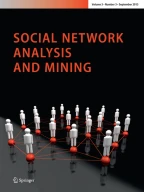Abstract
Triangle counting is an important problem in graph mining. The clustering coefficient and the transitivity ratio, two commonly used measures effectively quantify the triangle density in order to quantify the fact that friends of friends tend to be friends themselves. Furthermore, several successful graph-mining applications rely on the number of triangles in the graph. In this paper, we study the problem of counting triangles in large, power-law networks. Our algorithm, SparsifyingEigenTriangle, relies on the spectral properties of power-law networks and the Achlioptas–McSherry sparsification process. SparsifyingEigenTriangle is easy to parallelize, fast, and accurate. We verify the validity of our approach with several experiments in real-world graphs, where we achieve at the same time high accuracy and considerable speedup versus a straight-forward exact counting competitor. Finally, our contributions include a simple method for making link recommendations in online social networks based on the number of triangles as well as a procedure for estimating triangles using sketches.
Similar content being viewed by others
References
Achlioptas D, McSherry F (2001) Fast computation of low rank matrix approximation. In: Proceedings of 33rd STOC. ACM Press, New York
Alon N, Matias Y, Szegedy M (1996) The space complexity of approximating the frequency moments. In: STOC ’96: proceedings of the twenty-eighth annual ACM symposium on theory of computing, New York, NY, USA. ACM, New York, pp 20–29
Alon N, Yuster R, Zwick U (1997) Finding and counting given length cycles. Algorithmica 17(3):209–223
Alon N, Gibbons PB, Matias Y, Szegedy M (2002) Tracking join and self-join sizes in limited storage, pp 10–20
Bar-Yosseff Z, Kumar R, Sivakumar D (2002) Reductions in streaming algorithms, with an application to counting triangles in graphs. In: SODA ’02: proceedings of the thirteenth annual ACM-SIAM symposium on discrete algorithms, Philadelphia, PA, USA. Society for Industrial and Applied Mathematics, pp 623–632
Becchetti L, Boldi P, Castillo C, Gionis A (2008) Efficient semi-streaming algorithms for local triangle counting in massive graphs. In: Proceedings of ACM KDD, Las Vegas, NV, USA
Buriol LS, Frahling G, Leonardi S, Marchetti-Spaccamela A, Sohler C (2006) Counting triangles in data streams. In: PODS ’06: proceedings of the twenty-fifth ACM SIGMOD-SIGACT-SIGART symposium on principles of database systems, New York, NY, USA. ACM, pp 253–262
Chung F, Lu L, Vu V (2003) Eigenvalues of random power law graphs. Ann Comb 7(1):21–33
Coppersmith D, Winograd S (1987) Matrix multiplication via arithmetic progressions. In: STOC ’87: proceedings of the nineteenth annual ACM conference on theory of computing, New York, NY, USA. ACM, pp 1–6
Deerwester S, Dumais ST, Furnas GW, Landauer TK, Harshman R (1990) Indexing by latent semantic analysis. J Am Soc Inf Sci 41:391–407
Demmel J (1997) Applied numerical linear algebra. SIAM, Philadelphia
Drineas P, Kannan R (2003) Pass efficient algorithms for approximating large matrices. In: SODA ’03: proceedings of the fourteenth annual ACM-SIAM symposium on discrete algorithms, Philadelphia, PA, USA. Society for Industrial and Applied Mathematics, pp 223–232
Eckmann J-P, Moses E (2002) Curvature of co-links uncovers hidden thematic layers in the world wide web. PNAS 99(9):5825–5829
Faloutsos M, Faloutsos P, Faloutsos C (1999) On power-law relationships of the internet topology. In: SIGCOMM, pp 251–262
Farkas IJ, Derenyi I, Barabasi A-L, Vicsek T (2001) Spectra of “real-world” graphs: beyond the semi-circle law. Phys Rev E 64:1
Frieze A, Kannan R, Vempala S (1998) Fast Monte-Carlo algorithms for finding low-rank approximations. In: Proceedings of the 39th annual IEEE symposium on foundations of computer science, pp 370–378
Gilbert AC, Kotidis Y, Muthukrishnan S, Strauss MJ (2003) One-pass wavelet decompositions of data streams. IEEE TKDE 15:2003
Golub G, Van Loan C (1989) Matrix computations, 2nd edn. Johns Hopkins Press, Baltimore
Latapy M (2008) Main-memory triangle computations for very large (sparse (power-law)) graphs. Theor Comput Sci 407(1–3):458–473
Liben-Nowell D (2005) An algorithmic approach to social networks. PhD thesis, Massachusetts Institute of Technology, Electrical Engineering and Computer Science Department, June 2005
Mihail M, Papadimitriou C (2002) On the eigenvalue power law. In: Lecture notes on computer sciences, vol 2483. Springer, Berlin
Newman MEJ (2001) Clustering and preferential attachment in growing networks. Phys Rev E 64:016131
Newman MEJ (2003) The structure and function of complex networks. SIAM Rev 45:167–256
Schank T, Wagner D (2004) DELIS-TR-0043—finding, counting and listing all triangles in large graphs, an experimental study. Techreport 0043
Tsourakakis C (2008) Fast counting of triangles in large real networks, without counting: algorithms and laws. In: ICDM
Tsourakakis CE, Kang U, Miller GL, Faloutsos C (2009a) Doulion: counting triangles in massive graphs with a coin. In: Elder JF, Fogelman-Souli F, Flach PA, Zaki M (eds) Proceedings of KDD. ACM, pp 837–846
Tsourakakis CE, Kolountzakis MN, Miller GL (2009b) Approximate triangle counting. CoRR, abs/0904.3761
Turk M, Pentland A (1991) Eigenfaces for recognition. J Cogn Neurosci 3(1):71–86
Wasserman S, Faust K (1994) Social network analysis. Cambridge University Press, Cambridge
Author information
Authors and Affiliations
Corresponding author
Rights and permissions
About this article
Cite this article
Tsourakakis, C.E., Drineas, P., Michelakis, E. et al. Spectral counting of triangles via element-wise sparsification and triangle-based link recommendation. Soc. Netw. Anal. Min. 1, 75–81 (2011). https://doi.org/10.1007/s13278-010-0001-9
Received:
Accepted:
Published:
Issue Date:
DOI: https://doi.org/10.1007/s13278-010-0001-9
